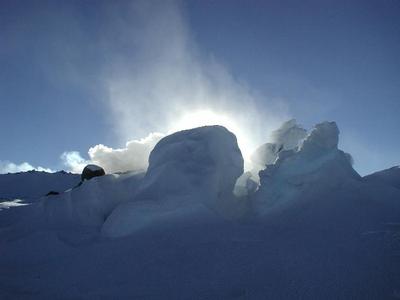10 December, 2001
The weather has changed here repeatedly, but as I look over the weather
data the one thing that has remained constant is the temperature. It is
almost always between 20 and 30 degrees below zero Celsius. The way that
feels does change. With moisture in the air (today) it feels colder, and
visibility is low. Wind makes a huge difference. We got work done in the
afternoon.
Emily Desmerais is doing research on the volcano using GPS (Global
Positioning Systems). This could be considered another way of FEELING
what the mountain is doing. As we have noted before, simple senses can be
taken far beyond human capacity with the help of technology. GPS has
become quite familiar to the general public. Using hand-held devices,
satellites can guide a hunter, hiker, or car driver to within meters of
their destination. One of the parameters that geologists are trying to
understand about the volcano is whether it is bulging, shrinking, or moving
in any way. The stationary GPS units that Emily is installing can detect
movement of the side of the mountain. They are very sensitive, and can
detect as little as 2 millimeters of movement. According to most of the
recent research, the volcano seems to be falling in on itself, or
shrinking. But not by much.
Most of the equipment used here is bulky, and intended to be implanted in
a solid rock substrate. Today, however, two members of the team used a
mobile GPS in a backpack to map the ice fumeroles that are found several
hundred meters north of the hut. Some interest has been taken in these
fumeroles lately. They change quite dramatically from year to year, and
mapping them can help to understand the pattern of gas emission from the
sides of the mountain.
Most of my day was taken up with driving materials from place to place
with a snowmobile, We had GPS installation materials to bring to Nausea
Knob (an old lava flow that juts out from the side of the mountain), and
wind generator materials to bring up the side of the volcano (several
trips). This wind generation station is designed to power the remote
television camera that looks down into the lava lake.
Last note: One of my personal goals has been to capture different types
of snow crystals in Antarctica. This evening at supper someone noticed
that tiny flowers of frost had formed on the surface of the snow. I tried
to capture some. They were very delicate, and I'm not sure it worked.
Something else very unusual happened today in this regard; it snowed. It
only snowed for about five minutes, and the crystals were tiny. I didn't
have time to get ready. There are snow crystals inside the fumeroles as
well, but I have had little luck with three dimensional specimens. I'll
try anyway.

Left: Emily Desmerais gets ready to map the ice fumeroles behind our camp. Within one hour she has generated a map that is accurate to a meter. The collection of data such as this can prove useful to future projects.

Left: I'm trying to capture some of the little ice flowers that appeared at the end of the day. Limited success. These crystals are more delicate than snowflakes, and blow away on contact. I got a few. They all share a central "stalk" that branches out in very similar ways >from crystal to crystal. Right: The crystals hanging from one of the "ceilings" in an ice fumerole behind camp. I'm still not quite sure how to capture these, but they're not going anywhere.

An ice tower steaming in the foreground. Mt. Erebus' plume in the back.
Contact the TEA in the field at
.
If you cannot connect through your browser, copy the
TEA's e-mail address in the "To:" line of
your favorite e-mail package.
|
